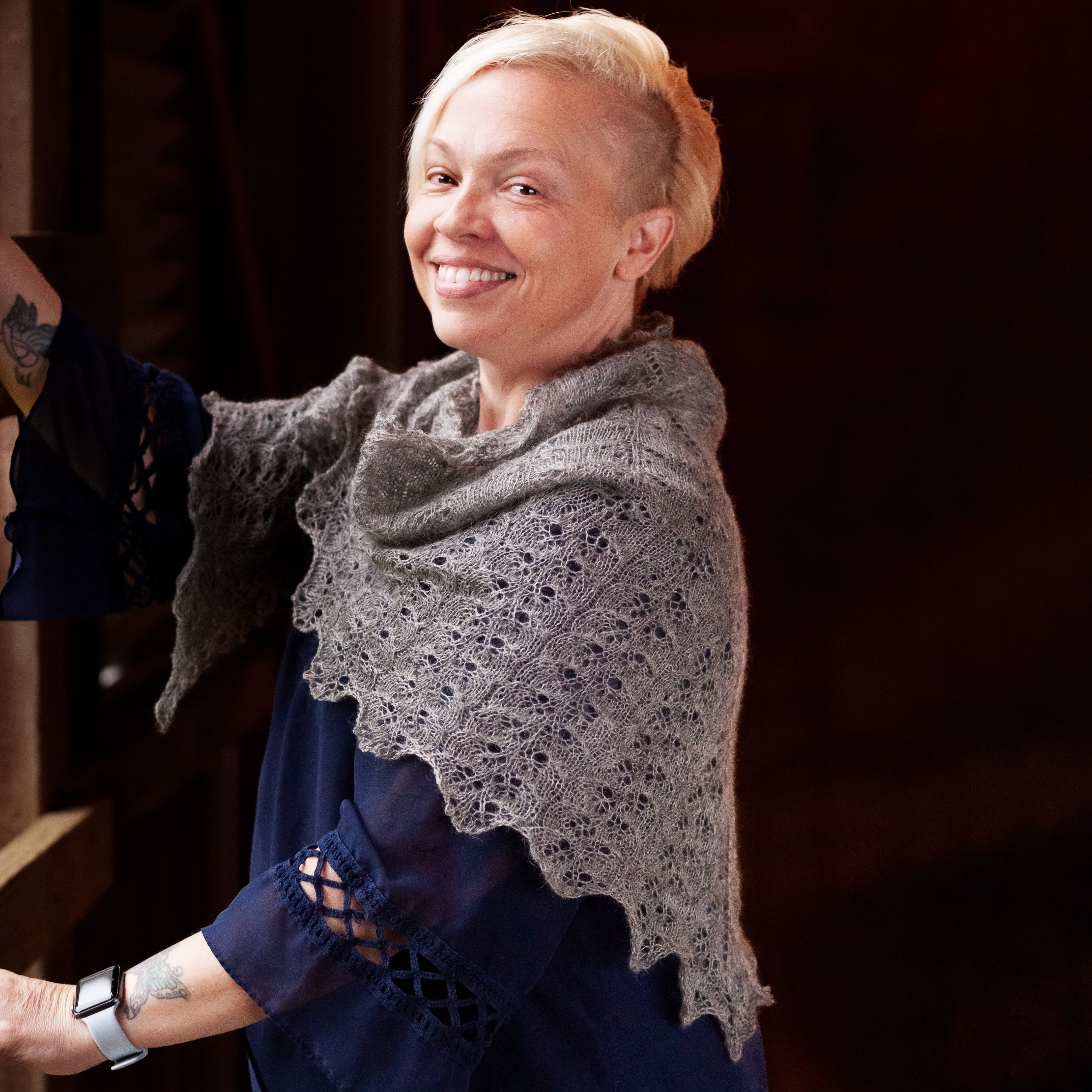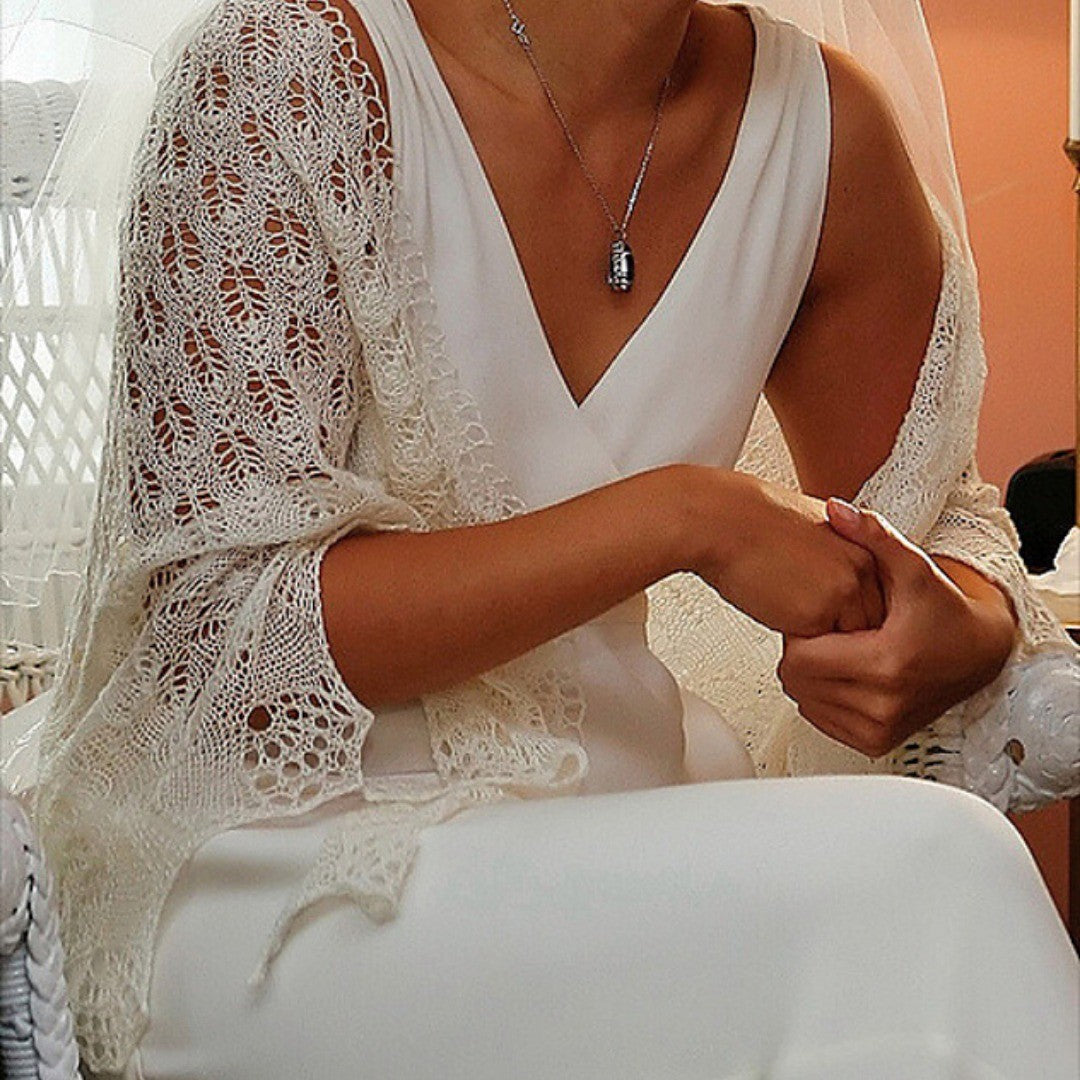We are too excited about our Mother's Day Special KIT—we just had to share something about the yarn with you!
First off, Spring Fever is a custom overdye on our natural Kent Lace base in the White Sand shade. We just love the varied background provided by this heathered blend of white, gray, and fawn wool. Our partner in this project—Nancy Marshall of Stone Walls Farm—created the perfect dye mix that allows the base shades to mingle with her custom blue color, Heavenly.
Are you ready for some exclusive insight from Nancy herself? Michelle came up with some questions that she thought we’d all like to know the answers to—read on!

How did your dyeing business begin?
Pretty much everything in life is sales. The trick is to enjoy it. Back in 2016, our town had a Big Flood. Our gallery (Walls Fine Art Gallery started in 1984) was at The Greenbrier Resort. When, after several weeks, life returned, guests at the resort were reluctant to pay more than $50 for anything. That was new. And weird. Our gallery represented original work by known artists. We had nothing under $50. I had knitted since I was a tiny kid (prehistory) and had been dyeing and spinning for many years, so, I asked my biz-partner-and-husband what he thought about adding yarns, knitting, and knitwear to The Gallery. Being the awesome guy he is, he was fine with the addition. For the last 2 years that we were at The Greenbrier, all rents were covered by yarns and knitting classes.
We have since moved to our own building on Main St in White Sulphur Springs, WV, and the storefront is one-side paintings and one-side yarns. So I didn't really start a business, I rode coattails.
But that's really the cover story. I'm actually just supporting, and probably encouraging the expansion of, my habit. Don't ask about stash or WIPs—I don't know.

Why hand-dyes as a biz?
I knitted a pair of Latvian mittens in 1975. (Oh yeah, I am that old.) I herded sheep in the French Alps in 1977 (yes, it was awesome). In 2005, my sister-in-law shipped me her fiber and spinning wheel because she had just had to clear out her parent’s house, and thinking ahead was clearing out her own Stuff (so her kids wouldn’t think SHE was nuts!). In the 70s I was in France in a painting school, and by the time I received the spinning wheel, I had been a portrait painter for years. Dyeing fibers was a natural step into another field of color and making things.
Whereas turning something you love into a business can drown that Loved Thing in taxes and paperwork and anything but the Loved Thing, I was already there with the gallery. Adding hand-dyed yarn to the what-I-love-about-going-to-work side of the scale was cost-free.

What materials do you use when dyeing?

What has been the most challenging process of dyeing?
Dyeing for Anne! I've been reading, knitting, and admiring Anne's work since the pre-Ravelry blogspot days. Gardening, home improvement, design development—I loved the whole lot. Dyeing for my shop is a breeze. Most of my clients are tourists who knit, and they happily make one skein purchase in support of an LYS. No dye lots. No sweater quantities. But 150 skeins? For a detail-noticing person like Anne? That is a whole new ball of wax.
We all see color slightly differently. Translating color from words and reference photos to yarn is a fun, mysterious, bewildering shot in the dark. After all, one solid color isn't COLOR. Color is relative; a color comes alive in juxtaposition with other colors. Even in Anne's beautifully constructed lace patterns, the final project benefits from gentle variation—but that variation can quickly get out of hand if I'm not careful. And if I'm too careful, then I'm sure to get it wrong!

What is your dyeing process?
I use primary dyes in a way that is similar to my painting palette—2 reds (1 lends itself to clean oranges, warm, and the other to violets, cool), 2 blues (1 loves greens and the other violets), 2 yellows (1 warm, 1 cool). Primary dyes are made of 1 color, not a mix of colors. They don't 'break' on their own. I blend the dyes to make the final color(s)—the same as painting.
A lot of dyers make their lovely yarn colors with premixed dyes (Dharma, Jacquard), and that's great—and maybe more predictable and repeatable. I take good notes, weigh everything, and make a mess. Did I not say my husband is awesome?

Dyeing with BNWs Wool
First, the Bare Naked Wools yarns that I've knitted have never pilled (A+, Gold Star).
Yarn bases that are commonly available for dyeing are often slick and uniform, and those bases have their uses. But whoever is doing the milling for Bare Naked is fabulous. There is a soft range of fiber mix, color, and thickness that speaks of human hands and hearts. I love dyeing BNW fiber blends because of that natural color variation, and all BNW yarns do take color so well.
From the gallery, we know two things about hand-made things. First, the more mature an artist is in his craft, the more the final product reveals that artist. And second, if we make something with our hands, the final product is instilled in our spirit. Why does that matter? Good hands, good people, and good vibes to take with you.
What was your process for making BNWs new Spring Fever Heavenly?
When I receive guidelines for a colorway, I use a yarn base that I have on hand to determine the expected dye process to achieve the desired color range. Because that usually means my wool-based trials, wool-based samples, to wool-based final skeins, it often works. Some yarn bases are less cooperative than others, some aren't wool at all, and require dyeing process overhauls. And then there are the sheep; the character of fleece from the same breed differs from farm to farm.

This blue had three initial color samples that used the same three dyes in differing concentrations. The final yarn base had a slightly browner nature which plays well with the blues and provides subtle shifts in hue. These skeins were dip-dyed in two separate, slightly different blue dye pots, two skeins at a time, in the first pot until the dye was exhausted, then the second until that dye was exhausted, and then into a third bath for another 30 minutes to make sure the dye was set. Then slow cooldown.


What projects are you currently working on?
We have the first new grandchild in 16 years coming in late summer, so there's a lot of baby stuff on the needles and wheel.
The undercurrent, however, stems from having too much fun blending fibers/colors on a drum carder. I have a laundry basket full of colorful mini-batts. Although I am by nature a tight, consistent spinner, I ogle art yarns. I'm a knitter. Not a weaver. Not a crocheter. How to work these crazy, bee-hive, tail-spun, sparkly (!?), loveable, one-of-a-kind, uneven, perhaps even poorly behaved, yarns into a functional (and hopefully appealing) bit of knitwear?
I'm usually alone with my craft (small town, not a lot of resident knitters), so I've started using video as a fiber connector. That's a whole other story.




